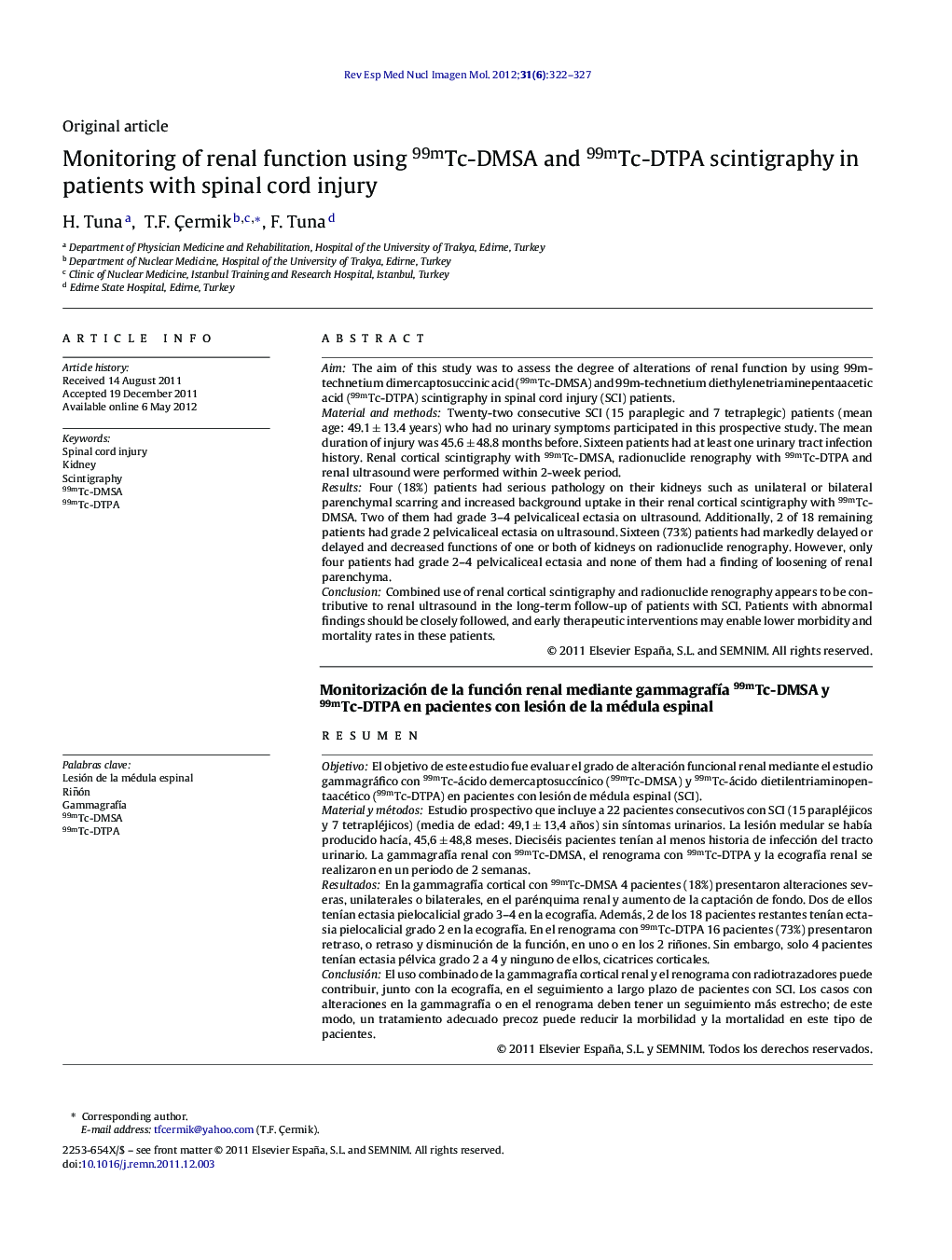| کد مقاله | کد نشریه | سال انتشار | مقاله انگلیسی | نسخه تمام متن |
|---|---|---|---|---|
| 4249900 | 1283877 | 2012 | 6 صفحه PDF | دانلود رایگان |

AimThe aim of this study was to assess the degree of alterations of renal function by using 99m-technetium dimercaptosuccinic acid (99mTc-DMSA) and 99m-technetium diethylenetriaminepentaacetic acid (99mTc-DTPA) scintigraphy in spinal cord injury (SCI) patients.Material and methodsTwenty-two consecutive SCI (15 paraplegic and 7 tetraplegic) patients (mean age: 49.1 ± 13.4 years) who had no urinary symptoms participated in this prospective study. The mean duration of injury was 45.6 ± 48.8 months before. Sixteen patients had at least one urinary tract infection history. Renal cortical scintigraphy with 99mTc-DMSA, radionuclide renography with 99mTc-DTPA and renal ultrasound were performed within 2-week period.ResultsFour (18%) patients had serious pathology on their kidneys such as unilateral or bilateral parenchymal scarring and increased background uptake in their renal cortical scintigraphy with 99mTc-DMSA. Two of them had grade 3–4 pelvicaliceal ectasia on ultrasound. Additionally, 2 of 18 remaining patients had grade 2 pelvicaliceal ectasia on ultrasound. Sixteen (73%) patients had markedly delayed or delayed and decreased functions of one or both of kidneys on radionuclide renography. However, only four patients had grade 2–4 pelvicaliceal ectasia and none of them had a finding of loosening of renal parenchyma.ConclusionCombined use of renal cortical scintigraphy and radionuclide renography appears to be contributive to renal ultrasound in the long-term follow-up of patients with SCI. Patients with abnormal findings should be closely followed, and early therapeutic interventions may enable lower morbidity and mortality rates in these patients.
ResumenObjetivoEl objetivo de este estudio fue evaluar el grado de alteración funcional renal mediante el estudio gammagráfico con 99mTc-ácido demercaptosuccínico (99mTc-DMSA) y 99mTc-ácido dietilentriaminopentaacético (99mTc-DTPA) en pacientes con lesión de médula espinal (SCI).Material y métodosEstudio prospectivo que incluye a 22 pacientes consecutivos con SCI (15 parapléjicos y 7 tetrapléjicos) (media de edad: 49,1 ± 13,4 años) sin síntomas urinarios. La lesión medular se había producido hacía, 45,6 ± 48,8 meses. Dieciséis pacientes tenían al menos historia de infección del tracto urinario. La gammagrafía renal con 99mTc-DMSA, el renograma con 99mTc-DTPA y la ecografía renal se realizaron en un periodo de 2 semanas.ResultadosEn la gammagrafía cortical con 99mTc-DMSA 4 pacientes (18%) presentaron alteraciones severas, unilaterales o bilaterales, en el parénquima renal y aumento de la captación de fondo. Dos de ellos tenían ectasia pielocalicial grado 3–4 en la ecografía. Además, 2 de los 18 pacientes restantes tenían ectasia pielocalicial grado 2 en la ecografía. En el renograma con 99mTc-DTPA 16 pacientes (73%) presentaron retraso, o retraso y disminución de la función, en uno o en los 2 riñones. Sin embargo, solo 4 pacientes tenían ectasia pélvica grado 2 a 4 y ninguno de ellos, cicatrices corticales.ConclusiónEl uso combinado de la gammagrafía cortical renal y el renograma con radiotrazadores puede contribuir, junto con la ecografía, en el seguimiento a largo plazo de pacientes con SCI. Los casos con alteraciones en la gammagrafía o en el renograma deben tener un seguimiento más estrecho; de este modo, un tratamiento adecuado precoz puede reducir la morbilidad y la mortalidad en este tipo de pacientes.
Journal: Revista Española de Medicina Nuclear e Imagen Molecular - Volume 31, Issue 6, November–December 2012, Pages 322–327